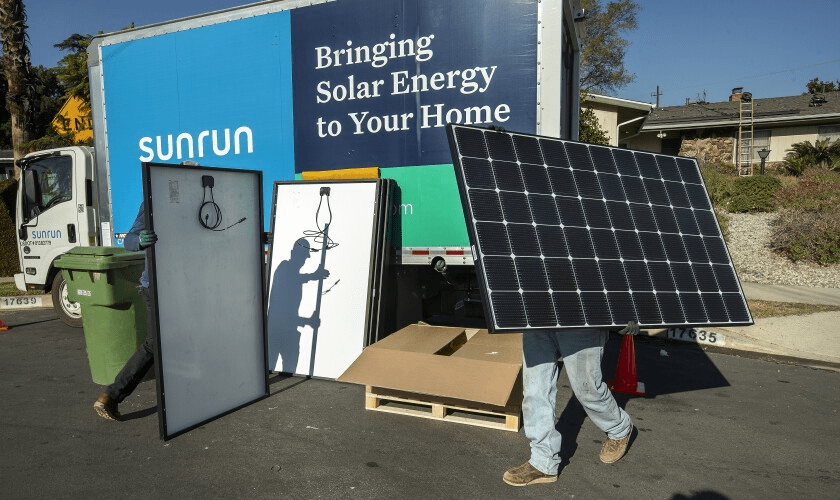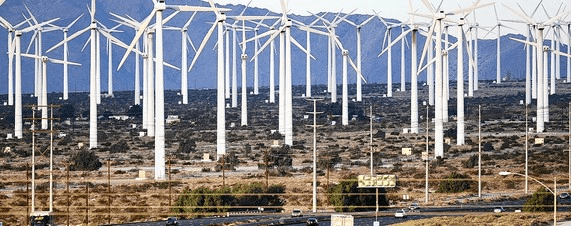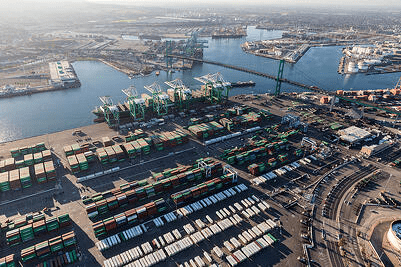In 2015, Time named Los Angeles (LA), California, as the city with the worst air pollution in the U.S. Two years later, the LA City Council voted to adopt measures to instruct local utilities on how best to achieve 100% renewable energy. Read more at la-future.
How California is transitioning to alternative energy

In 1984-1992, the first series of 13 solar thermal power plants of various capacities was built in California, in the Mojave Desert, 200 km northeast of LA. Also in California, in 1984, Carrizo Energy Solar Farm was opened. It produced electricity using solar energy. It is based on the direct conversion of solar energy into electricity using photovoltaic cells. Such cells convert direct radiation into electricity, as well as solar radiation and scattered radiation when it is cloudy.
California’s Renewables Portfolio Standard (RPS), established in 2002, requires utilities to purchase at least 20% of their electricity from renewable sources. In 2009, Governor Schwarzenegger signed an executive order to adopt rules raising the RPS to 33% by 2020. In 2011, Governor Jerry Brown signed a law codifying this requirement, requiring all California utilities to obtain 33% of the electricity they sell from renewable sources by 2020.
In addition, the Global Warming Solutions Act of 2006, known as AB 32, requires that greenhouse gas emissions be reduced to 1990 levels. This means a reduction of approx. 114 million metric tons compared to conventional projections.
Ambitious LA plans

LA gives itself 15 years to go 100% renewable. Solar photovoltaic, wind turbines, heat pumps and electric vehicles are part of the community’s program to achieve this goal.
The National Renewable Energy Laboratory (NREL) has concluded that LA can achieve 100% clean energy by 2035. We’ll see how a city of over 18 million people goes green. If LA achieves this, other major American cities will have to be just as ambitious.
According to NREL’s modeling, it is expected to cost approx. USD 86 billion to achieve 100% renewable electricity by 2035. What remains a mystery is what the city’s electricity bills will be.
The goal is the elimination of all fossil fuels from power generation. This will include the massive construction of photovoltaic solar power plants (solar farms) and wind turbines. The number of solar panels on rooftops, electric heat pumps in homes and electric cars in garages should multiply.
The new provisions, introduced by Mike Bonin and Paul Krekorian, recommend collaboration between the LA water and power company, the Los Angeles Department of Water and Power (LADWP), and local universities, energy agencies, energy professionals and other stakeholders to determine what priorities should be set and what investments should be made to meet the 100% renewable energy target.
First achievements

Since 2005, California has more than tripled its renewable energy usage, including rooftop solar. In 2019, renewables, hydropower, nuclear and other carbon-free sources provided 63% of the state’s electricity.
According to the plan of the NREL, fossil fuels will be eliminated by 2045. LA will close all its local gas plants, including Scattergood near El Segundo, Haines in Long Beach and Harbor in the Wilmington area of LA, near the ports. In early 2019, there were still plans to spend billions of dollars to install new gas-fired generators at these coastal plants. The proposal was scrapped under pressure from climate activists.
However, despite the rapid growth of renewable energy sources, it is still impossible to cut off natural gas in California. The reason is that when the sun goes down, solar power plants stop working. California must quickly and seamlessly replace this energy with other sources, such as hydropower and natural gas.
The state is rapidly constructing huge battery systems to store energy produced during daylight hours so it can be used when it goes dark. But so far, this is only a small fraction of what is needed.
While California is working toward long-term goals of 100% clean energy all year round, getting out of fossil fuels is no easy task.
Solar energy in ports

Since 2010, the Port of LA has implemented a number of projects to promote sustainable and responsible development, including landmark programs and initiatives to reduce emissions and greenhouse gases from port operations.
The use of solar energy has become one of the ways to reduce greenhouse gas emissions. As of 2022, the port has installed about 3 megawatts of solar photovoltaic systems. The photovoltaic systems supply clean energy to the utility grid operated by LADWP.
In 2015, the port set a new goal to install and operate photovoltaic systems at 12 additional locations on the port’s territory. Together, these new facilities have a total additional capacity of 10 MW of solar energy. This is approx. one-sixth of the port’s current electricity needs, or enough electricity to power about 2,500 homes. They combine rooftop, parking lot and off-ground locations. In 2022, almost half of these facilities were either under construction or nearing completion.
Replacing solar energy at night

California is working on storing additional renewable energy generated during the day so that it can be accessed late in the evening. The state is home to major battery projects. In the 2020s, energy storage in California increased 20-fold.
To replace solar energy when the sun goes down, California typically uses natural gas-fired power plants, importing from other states and hydroelectric power. However, the majority of large gas facilities are large industrial facilities. They are not suitable for rapid start-up. Many of them take 4 to 8 hours to turn on. To use them at sunset, they must be running during the day.
California might need new technologies to phase out fossil fuels. The use of stored energy can last for days, not hours, in cases of long periods of cloudy weather or lack of wind. Experts suggest that wind energy could play a bigger role, as it is more reliable to produce electricity in the evening.


